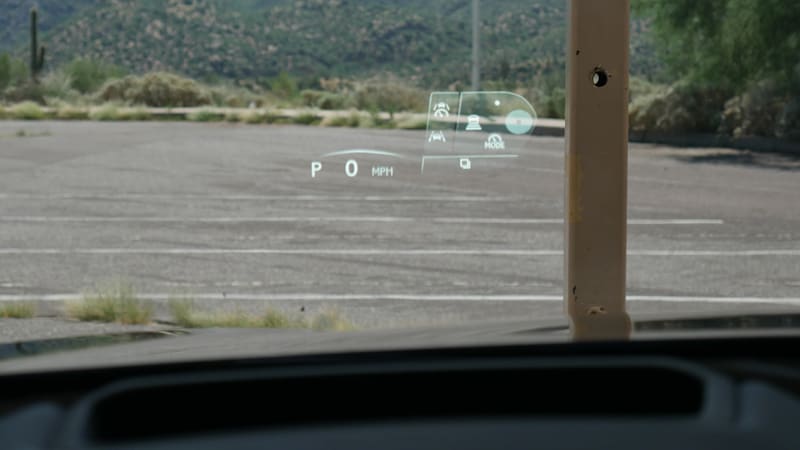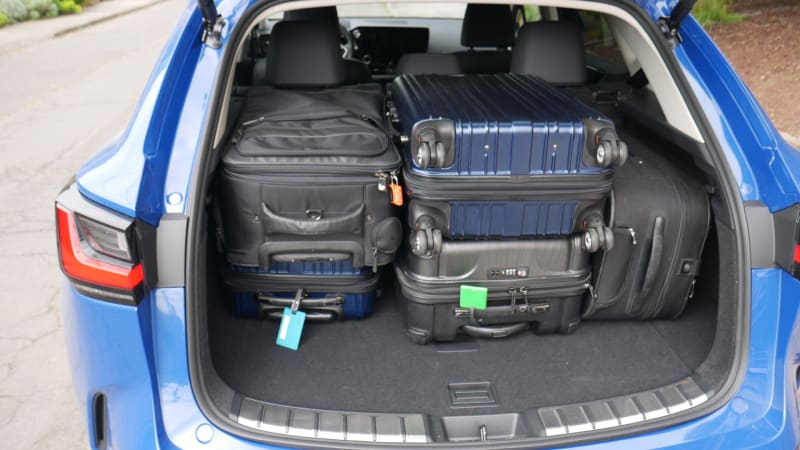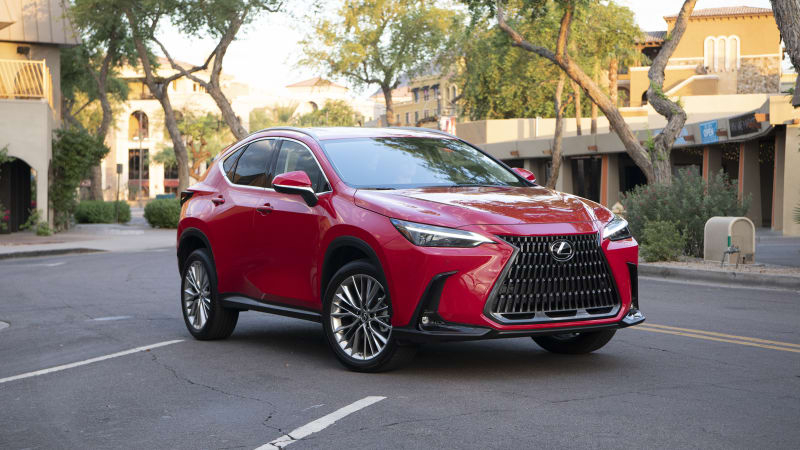2023 Lexus NX Review: You'll want the hybrids

Pros: Hybrid and PHEV are efficient and fun; sharp styling; lots of standard tech
Cons: Some of that tech is frustrating to use (especially the nonsensical HUD); less back seat space than some rivals
The 2023 Lexus NX came to us as an all-new crossover last year, and what made it good then is still true today. There are four different powertrain options — no shortage of choices — and the two hybrid options are easily our pick of the bunch. The more budget-friendly choice is the 350h, which is a regular hybrid, but the 450h+ PHEV adds an extra punch of performance with more power and an impressive 37 miles of all-electric range. Granted, the 450h+ is more expensive, but you’re getting a lot of capability for the cost and you’ll definitely be saving money on gas.
Lexus lets us down a bit with some irksome interior technology, including the latest Lexus infotainment system and the unusual reliance on the available head-up display to control various functions. The NX shouldn’t be your top pick in this compact luxury crossover segment if maximum utility is necessary, either — if you need a bigger Lexus, the RX will do the trick. Neither is the NX toward the top of the list when it comes to driving fun. The F Sport Handling models amp things up a bit with improved performance, but never cross the threshold into being a performance-oriented SUV like the Alfa Romeo Stelvio or BMW X3 (even just the Acura RDX will provide more engagement). Efficiency and a desire for Lexus-style luxury — which hopefully means reliability in the long term — are the two biggest reasons to put the NX at the top of your list
Interior & Technology | Passenger & Cargo Space | Performance & Fuel Economy
What it’s like to drive | Pricing & Features | Crash Ratings & Safety Features
What’s new for 2023?
The NX was completely new for 2022, and there are no notable changes made to the lineup for 2023. You can read about the redesigned 2022 model here.


What are the Lexus NX’s interior and in-car technology like?
While it may be difficult to tell the second-generation NX apart from its predecessor from a quick glance at the exterior, the same cannot be said of the cabin. The NX sports a redesigned interior bereft of the silly old touchpad infotainment interface Lexus committed to when this very model was introduced way back in 2014. A new touchscreen (yes, touchscreen) unit sits atop a center stack that no longer juts into the front passenger space. Instead, it sits over a concave center console that houses a new, Prius-inspired gear selector. The basic layout shares virtually nothing with the mainstream Toyota RAV4 and the materials used are appropriate for a Lexus. That said, we could do without the silly electronic door handles.
While the redesigned cabin helps the otherwise-identical-looking NX from coming off as completely stale, the biggest upgrades are technological, not aesthetic. The new infotainment system is powered by a standard 9.8-inch screen with dedicated physical climate control toggles or an optional 14-inch unit that incorporates a dedicated blend of touch-sensitive and physical comfort controls blended into the screen’s lower bezel. No matter which you choose, you get a physical volume knob. This represents a vast improvement over that found in the previous NX (and basically every other Lexus) but lacks split-screen functionality and some other basic items, like a dedicated home screen. Going between the native Lexus functions like radio or navigation, and the standard wireless Apple CarPlay/Android Auto connectivity screens is a constant source of tap-tap-tapping frustration.
The infotainment screen is fitted to a panel that blends into the instrument display, which itself features a 7-inch screen. Sixty-four-color ambient lighting is available, along with wireless charging and the bizarre 10-inch head-up display (pictured above right) that’s controlled by unmarked buttons on the steering wheel. It’s weird and difficult to use. There’s also standard integrated music streaming services such as Apple Music, a digital phone key, user profiles for car settings, a digital rearview mirror, plus an AI assistant that responds to natural speech commands.




How big is the Lexus NX?
The Lexus NX fits into the compact luxury SUV segment. Populated by the likes of the BMW X3, Audi Q5, Acura RDX and Genesis GV70, this class seems to grow larger every year — both in terms of the size of its constituents and the sheer quantity available. The NX itself gained an additional 5 cubic feet of cargo volume with its redesign but that did virtually nothing to improve its stature in a field where it remains one of the smallest entries, comparable to the likes of the Alfa Romeo Stelvio. In fact, although the NX’s exterior dimensions significantly exceed those of subcompacts like the BMW X1, Audi Q3 and Mercedes GLA, its interior dimensions are quite similar.
That said, we found that the cargo area is more useful than its modest 22-cubic-foot measurement would suggest. In our luggage test, we managed to fit our usual six pieces of baggage with room to spare. That includes the sizable under-floor storage bin found on every NX model (in fact, cargo space is equal regardless of powertrain), which not only provides enough space for a duffel bag or groceries, but is designed to thoughtfully store the cargo cover inside the car.




What are the NX’s fuel economy and performance specs?
The NX now comes with four available engines and is offered in both front- and all-wheel-drive configurations.
The new NX 250 (above, top left corner) has a 2.5-liter naturally aspirated four-cylinder. Paired with an eight-speed automatic, it produces 203 horsepower and 184 pound-feet – just as that engine does in its platform relative, the Toyota RAV4. With front-wheel drive, this is rated at 26 mpg city, 33 mpg highway and 28 mpg combined. Opting for all-wheel drive only costs 1 mpg (both city and highway), for final figures of 25/32/28.
The NX 350 (above, bottom left corner) and its new 2.4-liter turbocharged inline-four are good for 275 hp and 317 lb-ft of torque. That output exceeds the BMX X3 xDrive30i, Mercedes GLC 300 and Acura RDX, especially in terms of torque. Oddly, though, its estimated 0-60 time of 6.6 seconds is also about a half-second slower than the X3 and GLC despite its power advantage. It’s rated at 22 mpg city, 29 mpg highway and 25 mpg combined with its standard all-wheel drive.
The NX 350h hybrid (above, top right) produces 239 total system horsepower. This system incorporates an electronically controlled continuously variable transmission and because of its standard rear motor, includes all-wheel drive. Fuel economy checks in at 41 mpg city, 37 mpg highway and 39 mpg combined.
Ultimately, the most appealing powertrain option is found in the NX 450h+ plug-in hybrid (above, bottom right). Its electric motor provides the smooth, effortless punch expected of a PHEV thanks to its 304 total system horsepower. It can travel an EPA-estimated 37 miles on electric power alone. The miles-per-gallon-equivalent rating used to estimate a PHEV’s fuel economy comes in at 84 MPG-e.
A tow package allows the NX to trailer up to 2,000 pounds.

What’s the NX like to drive?
The NX’s powertrain overhaul transformed it from one of the least-potent compact crossovers to one of the strongest on paper, but it’s still not really a performance-focused model. The 450h+ plug-in hybrid and 350 turbo are both powerful but heavy, and the softly suspended NX (even in F Sport guise) errs on the side of comfort. The steering is also devoid of feedback and putting the car in Sport mode adds too much effort, as if that’s all it takes to make a car’s steering engaging. Old trick, not an effective one. The ride is comfortable as excepted, and although the F Sport’s bigger wheels do add some impact harshness, its adaptive suspension helps smooth out the rougher edges.
As for the powertrain choices, we’d stick with the hybrids. The base engine is lifted right out of the Toyota RAV4 and it feels and sounds just like it. Power is unremarkable for a luxury vehicle, and even if that’s totally OK with you, the rather course engine note we begrudgingly tolerate in the RAV4 is just uncouth in a Lexus. The Hybrid powertrain, which is far more refined than the last NX hybrid’s is a better choice, especially since it comes with a big-time fuel economy benefit (even if it too is shared with the RAV4). The new 350’s turbo engine comes with a big-time power benefit that you’ll definitely want if that “power is unremarkable for a luxury vehicle” concern above struck a chord, but as previously stated, it hardly establishes the NX as a performance choice. The 450h+ plug-in hybrid adds a bunch of smooth, instantaneous low-end power to the mix, and is therefore the best choice for achieving an ideal balance of performance and fuel consumption.
What other Lexus NX reviews can I read?
2022 Lexus NX First Drive Review | Believe us, it really is all new
This quietly competent crossover is at its best in NX 450h+ plug-in hybrid form

2022 Lexus NX touchscreen infotainment review
New touchscreen signals the end of Remote Touch and the future of Lexus tech

2022 Lexus NX 450h+ Road Test: A notch better than good enough
We dive deep on the 450h+ PHEV version of the Lexus NX, our favorite version of Lexus’ compact SUV.

How much is the 2023 NX’s price and what features are available?
The NX can be had in six different variants, starting with the NX 250 at $40,905. This FWD model is fairly barebones, offering synthetic seating surfaces, eight-way power adjustable front seats, a 10-speaker audio system and wireless Android Auto and Apple CarPlay. LED headlights and DRLs are also standard, as are auto-dimming side mirrors.
Higher-end models like the 350h and 450h+ are available with such luxury features as an excellent 17-speaker Mark Levinson audio system, integrated navigation (with the 12-inch infotainment system), a heated steering wheel and a power liftgate, among many others.
Each trim above the base comes standard with AWD and increasingly robust powertrains and interior packages. Both the turbocharged NX 350 AWD and the NX 450h+ can be optioned with an F Sport handling package that adds adaptive dampers, F Sport seats with bigger bolsters, 20-inch black-painted wheels and more. Here’s a full trim breakdown with destination charges included:
NX 250: $$40,905
NX 250 AWD: $42,505
NX 350 AWD: $44,665
NX 350 F Sport Handling AWD: $50,215
NX 350h AWD: $44,255
NX 450h+ AWD: $58,855
NX 450h+ F Sport Handling AWD: $61,055
What are the NX’s safety ratings and driver assistance features?
The 2023 Lexus NX has not yet been crash tested by the NHTSA, but the IIHS awarded the 2022 model with its highest-possible Top Safety Pick+ honors. It scored the best-possible results in all crash tests and even got top marks in the difficult-to-pass headlight test.
Standard safety equipment on the 2023 NX includes adaptive cruise control with stop/start functionality; forward and rear collision detection, avoidance and automatic emergency braking; lane keeping assist and lane departure warning with steering intervention; automatic high beams and blind-spot warning. The car will also prevent you from opening the doors if it detects incoming cars and cyclists from the rear.
Available safety features include a surround-view camera system, an enhanced blind-spot warning system, front cross-traffic alerts, corner-adaptive headlights and a digital rearview mirror.
Related Video:



